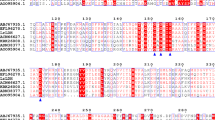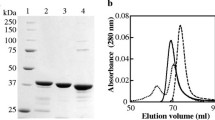Abstract
Clostridium acetobutylicum strain P262 utilized lactate at a rapid rate [600 nmol min−1 (mg protein)−1], but lactate could not serve as the sole energy source. When acetate was provided as a co-substrate, the growth rate was 0.05h−1. Butyrate, carbon dioxide and hydrogen were the end products of lactate and acetate utilization, and the stoichiometry was 1 lactate + 0.4 acetate →0.7 butyrate + 0.6H2 + 1CO2. Lactate-grown cells had twofold lower hydrogenase than glucose-grown cells, and the lactate-grown cells used acetate as an alternative electron acceptor. The cells had a poor affinity for lactate (Ks=1.1 mM), and there was no evidence for active transport. Lactate utilization was catabolyzed by an inducible NAD-independent lactate dehydrogenase (iLDH) that had a pH optimum of 7.5. The iLDH was fivefold more active withd-lactate thanl-lactate, and theK m ford-lactate was 3.2 mM. Lactate-grown cells had little butyraldehyde dehydrogenase activity, and this defect did not allow the conversion of lactate to butanol.
Similar content being viewed by others
Abbreviations
- MTT :
-
3-(4,5-dimethylthiazol-2-yl)-2,5-diphenyltetrazolium bromide
- PMS :
-
phenazine methosulfate
- nLDH :
-
NAD-dependent lactate dehydrogenase
- iLDH :
-
NAD-independent lactate dehydrogenase
- Fru-1,6-P 2 :
-
fructose-1,6-bisphosphate
- DTT :
-
dithiothreitol
- ΔΨ:
-
membrane potential
- TPP + :
-
tetraphenylphosphonium bromide
References
Andersch W, Bahl H, Gottschalk G (1983) Level of enzymes involved in acetate, butyrate, acetone and butanol fermentation byClostridium acetobutylicum. Eur J Appl Microbiol Biotechnol 18:327–332
Andreesen JR, Bahl H, Gottschalk G (1989) Introduction to the physiology and biochemistry of the genusClostridium. In: Minton NP, Clarke DJ (eds) Clostridia. Plenum Press, New York, pp 27–63
Bahl H, Gottwald M, Kuhn A, Rale V, Andersch W, Gottschalk G (1986) Nutritional factors affecting the ratio of solvents produced byClostridium acetobutylicum. Appl Environ Microbiol 52:169–172
Barker HA, Stadtman ER, Kornberg A (1955) Coenzyme A transphorase fromClostridium kluyveri. In: Colowick SP, Kaplan NO (eds) Methods in enzymology, vol 1. Academic Press, New York, pp 599–600
Bhat JV, Barker HA (1947)Clostridium nov. spec. the role of acetic acid in the butyric acid fermentation of lactate. J Bacteriol 54:381–391
Brockman HL, Wood WA (1975)d-Lactate dehydrogenase ofPeptostreptococcus elsdenii. J Bacteriol 124:1454–1461
Cato EP, George WL, Finegold SM (1986) GenusClostridium Prazmowski. In: Sneath PHA, Mair NS, Sharpe ME, Holt JG (eds) Bergey's manual of systematic bacteriology. Williams and Wilkins, Baltimore, pp 1149–1152
Chen JS, Mortenson LE (1974) Purification and properties of hydrogenase fromClostridium pasteurianum W 5. Biochim Biophys Acta 371:283–298
Cook GM, Morgan HW (1994) Hyperbolic growth ofThermoanaerobacter thermohydrosulfuricus (Clostridium thermohydrosulfulicum) increases ethanol production in pH-controlled batch culture. Appl Microbiol Biotechnol 41:84–89
Datta R, Zeikus JG (1985) Modulation of acetone-butanol fermentation by carbon monoxide and organic acids. Appl Environ Microbiol 49:522–529
Freier D, Gottschalk G (1987)l(+)-Lactate dehydrogenase ofClostridium acetobutylicum is activated by fructose-1,6-bisphosphate. FEMS Microbiol Lett 43:229–233
Futai M (1973) Membraned-lactate dehydrogenase fromEscherichia coli. Purification and properties. Biochemistry 12:2468–2474
Garvie EI (1980) Bacterial lactate dehydrogenases. Microbiol Rev 44:106–139
Gutmann I, Wahlefeld A (1974)l(+)-Lactate: determination with lactate dehydrogenase and NAD. In: Bergmeyer HU (ed) Methods of enzymatic analysis. Academic Press, New York, pp 1464–1468
Harold FM, Levin E (1974) Lactic acid translocation: terminal step in glycolysis byStreptococcus faecalis. J Bacteriol 117:1141–1148
Hartmanis MG, Gatenbeck S (1984) Intermediary metabolism inClostridium acetobutylicum: levels of enzymes involved in the formation of acetate and butyrate. Appl Environ Microbiol 47:1277–1283
Haugaard N (1959)d-andl-lactic acid oxidases ofEscherichia coli. Biochim Biophys Acta 31:66–72
Huang L, Gibbins LN, Forsberg CW (1985) Transmembrane pH gradient and membrane potential inClostridium acetobutylicum during growth under acetogenic and solventogenic conditions. Appl Environ Microbiol 50:1043–1047
Hüsemann MHW, Papoutsakis ET (1989) Enzymes limiting butanol and acetone formation in continuous and batch cultures ofClostridium acetobutylicum. Appl Microbiol Biotechnol 31:435–444
Jones DT, Woods DR (1989) Solvent production. In: Minton NP, Clarke DJ (eds) Clostridia. Plenumn Press, New York, pp 105–144
Junelles AM, Janati-Idrissi R, Petitdemange H, Gay R (1988) Iron effect on acetone-butanol fermentation. Curr Microbiol 17:47–51
Lowry OH, Rosebrough NJ, Farr AL, Randall RJ (1951) Protein measurement with the Folin phenol reagent. J Biol Chem 193:265–275
Olsen EB, Russell JB, Henick-Kling T (1991) Electrogenicl-malate transport byLactobacillus plantarum: a basis for energy derivation from malolactic fermentation. J Bacteriol 173:6199–6206
Otto R, Sonnenberg ASM, Veldkamp H, Konings WN (1980) Generation of an electrochemical proton gradient inStreptococcus cremoris by lactate efflux. Proc Natl Acad Sci USA 77:5502–5506
Palosaari NR, Rogers P (1988) Purification and properties of the inducible coenzyme A-linked butyraldehyde dehydrogenase fromClostridium acetobutylicum. J Bacteriol 170:2971–2976
Rogers P, Gottschalk G (1993) Biochemistry and regulation of acid and solvent production in clostridia. In: Woods DR (ed) The clostridia and biotechnology. Butterworth-Heinemann, Boston, pp 25–50
Stadtman ER (1957) Preparation assay of acyl coenzyme A and other thiol esters; use of hydroxylamine. In: Colowick SP, Kaplan NO (eds) Methods in enzymology, vol 3. Academic Press, New York, pp 931–941
Thauer RK, Jungerman K, Decker K (1977) Energy conservation in chemotrophic anaerobic bacteria. Bacteriol Rev 41:100–180
Tholozan JL, Touzel JP, Samain E, Grivet JP, Prensier G, Albagnac G (1992)Clostridium neopropionicum sp. nov. a strict anaerobic bacterium fermenting ethanol to propionate through acrylate pathway. Arch Microbiol 157:249–257
Wolin MJ (1964) Fructose 1,6-diphosphate requirement of streptococcal lactic dehydrogenases. Science 146:775–777
Woolford MK (1984) The chemistry of silage. In: Woolford MK (ed) The silage fermentation. Marcel Dekker, New York, pp 71–133
Author information
Authors and Affiliations
Rights and permissions
About this article
Cite this article
Diez-Gonzalez, F., Russell, J.B. & Hunter, J.B. The role of an NAD-independent lactate dehydrogenase and acetate in the utilization of lactate byClostridium acetobutylicum strain P262. Arch. Microbiol. 164, 36–42 (1995). https://doi.org/10.1007/BF02568732
Received:
Accepted:
Issue Date:
DOI: https://doi.org/10.1007/BF02568732




